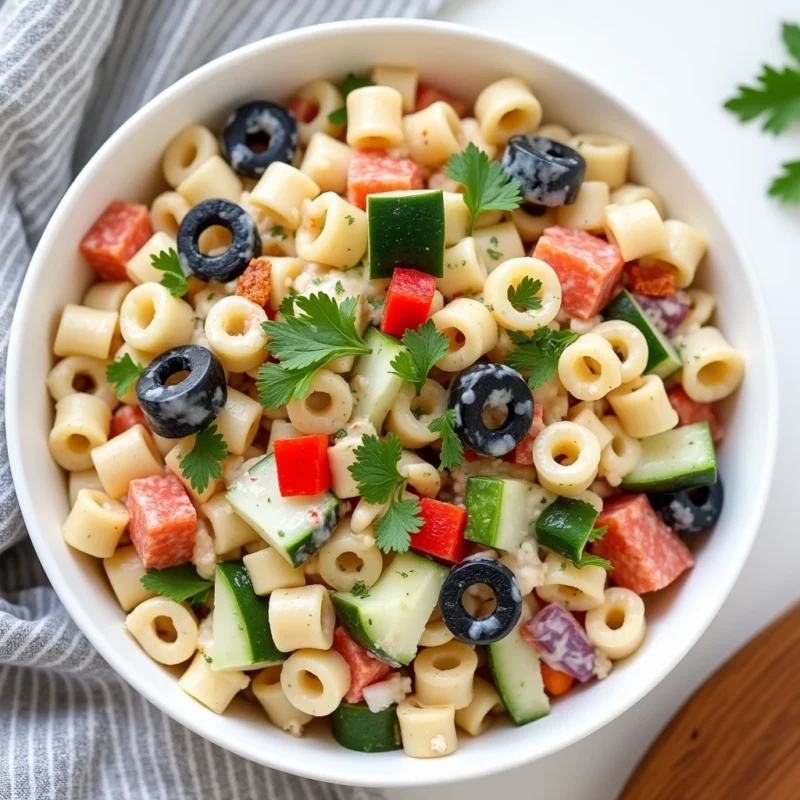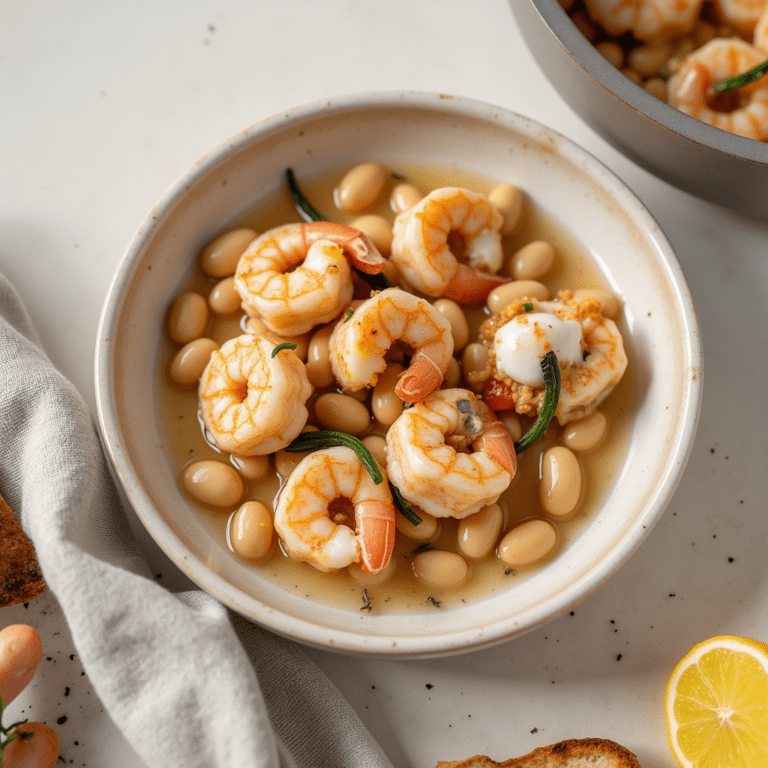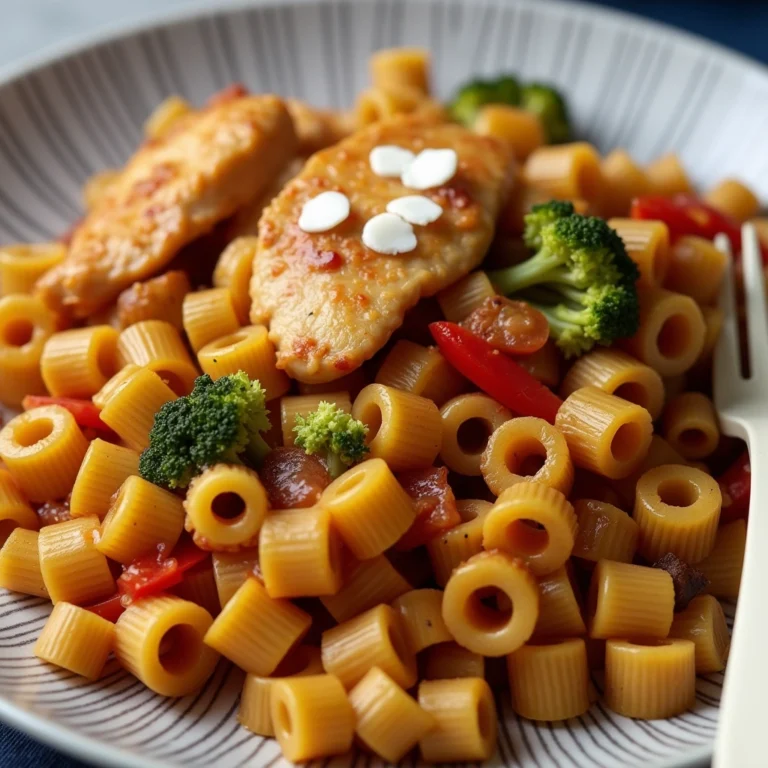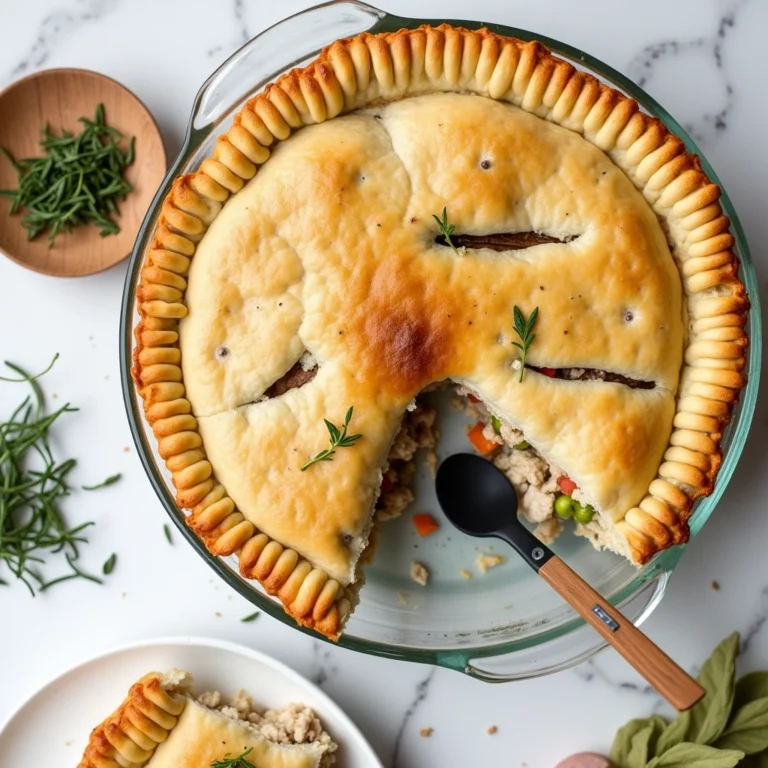The best Ditalini Pasta Salad : Fresh, Easy and Tasty
Discover a quick, healthy, and delicious Ditalini Pasta Salad with peas. This refreshing recipe is perfect for any meal and packed with flavor. Try it today! Contents hide 1 Introduction to ditalini Pasta 2 Popular Ditalini Pasta Recipes with ingredients 2.1 1. Minestrone Soup with Ditalini Pasta 2.2 2. Ditalini Pasta Salad 2.3 3. Creamy…
Discover a quick, healthy, and delicious Ditalini Pasta Salad with peas. This refreshing recipe is perfect for any meal and packed with flavor. Try it today!
Introduction to ditalini Pasta
Ditalini pasta is a small, tubular pasta shape that is commonly used in Italian cuisine. The name “ditalini” comes from the Italian word “dita,” which means “finger,” due to the pasta’s small size, which is roughly the size of a finger. This shape is particularly known for its short length and cylindrical form, making it perfect for soups, stews, and salads.
Often used in traditional Italian dishes, ditalini pasta’s compact shape allows it to absorb sauces and flavors well, making it a versatile ingredient in various recipes. The tubes are hollow, which helps them hold both thin broths and thick, chunky sauces. Ditalini pasta is typically made from durum wheat semolina, giving it a firm texture that holds up well during cooking, even in long simmering dishes like soup.
Popular Ditalini Pasta Recipes with ingredients
Ditalini pasta is incredibly versatile and can be used in a variety of dishes, from hearty soups to refreshing salads. Here are some popular recipes that highlight the pasta’s ability to absorb flavors and work well with different ingredients:
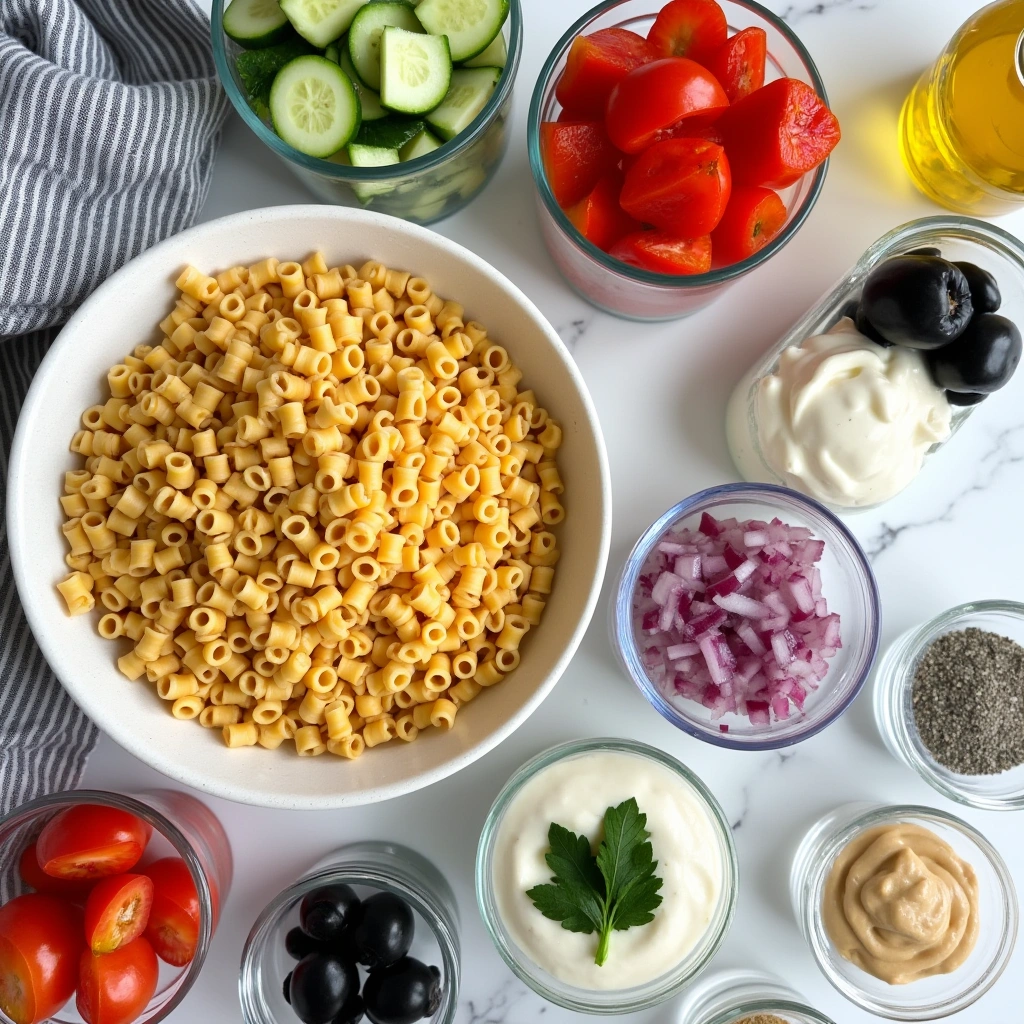
1. Minestrone Soup with Ditalini Pasta
One of the most traditional dishes featuring ditalini pasta is minestrone soup. This classic Italian soup is packed with vegetables like tomatoes, carrots, celery, onions, and beans, along with a flavorful broth. Ditalini pasta adds a comforting, bite-sized element to the dish. Here’s how to make it:
- Ingredients: Carrots, celery, onions, tomatoes, garlic, beans (such as kidney beans or cannellini), vegetable broth, pasta, and fresh herbs.
- Method: Sauté the vegetables, add the broth and herbs, and let it simmer. Add the pasta towards the end, cooking until tender. Top with grated Parmesan cheese and a drizzle of olive oil for extra flavor.
2. Ditalini Pasta Salad
This pasta also works wonderfully in a pasta salad. Its small, tubular shape is perfect for holding onto a variety of ingredients and dressings. This dish is ideal for picnics, barbecues, or as a side dish for any meal.
- Ingredients: pasta, cherry tomatoes, cucumbers, red onions, olives, feta cheese, and a vinaigrette dressing.
- Method: Cook the ditalini and let it cool. In a large bowl, combine the pasta with the chopped vegetables, olives, and feta cheese. Toss everything with a vinaigrette made from olive oil, red wine vinegar, mustard, salt, and pepper.
3. Creamy Ditalini Pasta with beef and Peas
For a rich and indulgent dish, try a creamy ditalini pasta. This recipe combines beef, sweet peas, and a creamy sauce that coats the pasta perfectly.
- Ingredients: Ditalini pasta, beef, peas, heavy cream, Parmesan cheese, garlic, and a touch of lemon zest for brightness.
- Method: Cook the pasta and set it aside. In a skillet, cook the beef , then sauté garlic and peas. Add the cream and Parmesan to create a rich sauce. Toss the pasta in the sauce and let it absorb the flavors. Top with extra Parmesan and a sprinkle of fresh herbs.
4. Ditalini Pasta with Tomato Basil Sauce
For a simpler, lighter dish, tomato basil sauce with ditalini is a classic choice. The sweetness of the tomatoes and the fragrance of fresh basil make this dish both refreshing and flavorful.
- Ingredients: Ditalini pasta, canned tomatoes, fresh basil, garlic, olive oil, and Parmesan cheese.
- Method: Sauté garlic in olive oil, then add crushed tomatoes and simmer until thickened. Stir in fresh basil and season with salt and pepper. Toss the cooked ditalini pasta in the sauce, adding Parmesan to finish.
5. Ditalini Pasta and White Bean Stew
This rustic stew is both hearty and nutritious, featuring ditalini pasta, white beans, and a savory broth. It’s perfect for a cozy dinner.
- Ingredients: Ditalini pasta, white beans (like cannellini), garlic, onions, vegetable or chicken broth, kale or spinach, and olive oil.
- Method: Sauté the garlic and onions, then add the broth and beans. Let it simmer for a while, then add the kale or spinach. Cook the ditalini pasta separately and combine it with the stew before serving.
6. Ditalini Pasta with Roasted Vegetables
For a vegetable-forward dish, try roasted vegetables with ditalini pasta. The roasted vegetables provide a smoky, sweet contrast to the pasta, making it a satisfying meal.
- Ingredients: pasta, bell peppers, zucchini, eggplant, red onions, garlic, olive oil, and balsamic vinegar.
- Method: Roast the vegetables in the oven until tender and caramelized. Meanwhile, cook the pasta. Toss the pasta with the roasted vegetables, drizzle with balsamic vinegar, and finish with fresh herbs like basil or thyme.
7. Ditalini Pasta in Brodo (Broth)
For a simple and flavorful Italian meal, ditalini in brodo (pasta in broth) is a traditional comfort dish. It’s a light yet satisfying meal, especially for colder weather.
- Ingredients: pasta, chicken or vegetable broth, Parmesan cheese, and fresh herbs.
- Method: Heat the broth in a pot, and once boiling, add the pasta. Cook until the pasta is al dente. Serve with a sprinkle of Parmesan cheese and fresh herbs like parsley.
Ditalini pasta is small, tube-shaped, and perfect for soaking up dressings and mingling with chopped vegetables. It also makes an excellent base for creamy ditalini pasta dishes if you’re looking for something richer next time.
Ideal Cooking Methods for Ditalini Pasta
These recipes show the versatility of ditalini pasta, from hearty soups to light salads, making it an excellent addition to any meal.
When cooking with this pasta, it’s important to use the right methods to ensure the best texture and flavor. Here are the ideal cooking techniques for this type of pasta:
1. Boiling in Plenty of Water
Ditalini pasta should always be cooked in a large pot of salted boiling water. The general rule of thumb is to use about 4-6 quarts of water per pound of pasta. This allows the pasta to cook evenly and prevents it from sticking together. Be sure to salt the water generously, as this will help enhance the pasta’s flavor.
2. Cooking Time
Its takes generally takes around 7-9 minutes to cook al dente, though you should always refer to the package instructions for the most accurate cooking time. The pasta should have a firm bite when finished, as it will continue to cook slightly when added to a soup or sauce. To check for doneness, taste a piece about a minute before the recommended time is up.
3. Stirring Frequently
While the pasta is boiling, stir occasionally to ensure the ditalini doesn’t stick to the bottom of the pot or to itself. This is especially important for smaller pasta shapes like ditalini.
4. Draining and Rinsing
Once cooked, drain the pasta in a colander. If you are using it in a cold dish or salad, you may want to rinse the pasta briefly under cold water to stop the cooking process and cool it down. For hot dishes, it’s generally better to skip rinsing, as the starchy coating on the pasta helps sauces adhere better.
5. Finishing in the Sauce (Optional)
If you are making a pasta dish with sauce, it’s often a good idea to finish cooking the ditalini in the sauce for 1-2 minutes. This allows the pasta to absorb some of the flavors of the sauce and creates a better cohesion between the pasta and the dish.
6. Avoid Overcooking
Since ditalini pasta is often used in soups or other dishes where it may continue to cook, avoid overcooking it when boiling. Slightly undercooking the pasta ensures that it holds up well and doesn’t become mushy once it’s added to the soup or other ingredients.
By following these simple steps, you can ensure that your pasta retains its perfect texture and flavor in any dish.
General background info on Ditalini pasta. Ditalini Pasta– Wikipedia
Health Benefits of Ditalini Pasta
Ditalini pasta, like many other types of pasta, can offer several health benefits, particularly when prepared in balanced, nutritious dishes. While pasta is often associated with high-carb content, it can still be part of a healthy diet when consumed in moderation and combined with the right ingredients. Here are some of the health benefits of this pasta :
1. Source of Energy
Pasta is primarily made from durum wheat semolina, which is a good source of carbohydrates. Carbohydrates are the body’s main energy source, providing the fuel necessary for daily activities and bodily functions. this pasta , when consumed as part of a balanced meal, provides long-lasting energy.
2. High in Fiber (When Made with Whole Wheat)
Traditional ditalini pasta is made from refined flour, but there are whole wheat versions available that provide significantly more fiber. Fiber is crucial for digestive health as it helps to maintain regular bowel movements and can prevent constipation. It also plays a role in lowering cholesterol levels and controlling blood sugar spikes, making it a good choice for those with diabetes or heart disease.
3. Rich in Protein
While pasta is not typically considered a high-protein food, it still contains a moderate amount of protein, particularly in higher-quality pasta made from durum wheat. Protein is essential for building and repairing tissues, making enzymes, and supporting overall muscle growth and recovery.
4. Low in Fat
Ditalini pasta is naturally low in fat, especially when compared to many other processed and packaged foods. When prepared with healthy ingredients like olive oil and fresh vegetables, pasta can be a low-fat meal option. This makes it suitable for those looking to maintain a healthy weight or reduce overall fat intake.
5. Good Source of B Vitamins
Pasta, especially the enriched variety, contains several essential B vitamins such as thiamine, niacin, riboflavin, and folic acid. These vitamins are vital for converting food into energy, maintaining healthy skin, and supporting nervous system function. Folate, in particular, is important for cell growth and development and is especially crucial for pregnant women.
6. Customizable for Different Dietary Needs
Ditalini pasta is versatile, and with the wide variety of pasta options available today, it can be tailored to different dietary needs. There are gluten-free versions made from rice flour, corn flour, or chickpea flour, which are ideal for those with gluten sensitivities or celiac disease. Additionally, whole grain or legume-based pasta options provide more fiber and nutrients than traditional refined pasta.
7. Supports a Balanced Diet
When paired with nutrient-dense ingredients, such as vegetables, lean proteins, and healthy fats, this pasta can be part of a well-rounded meal. Dishes that incorporate fresh vegetables, legumes, and a lean protein source (like chicken or tofu) provide a variety of vitamins, minerals, and antioxidants, making the pasta a balanced option for those looking to maintain a healthy diet.
8. May Promote Heart Health
When included as part of a Mediterranean-style diet, which is rich in fruits, vegetables, whole grains, legumes, and healthy fats, this type of pasta can contribute to better heart health. The fiber in whole wheat or legume-based pasta can help lower LDL (bad) cholesterol levels, and when paired with heart-healthy ingredients like olive oil, garlic, and leafy greens, it can help reduce the risk of cardiovascular disease.
9. Supports Bone Health
Durum wheat, the main ingredient in ditalini pasta, contains trace amounts of minerals like iron, magnesium, and zinc. While these minerals are not present in huge quantities in pasta, they can contribute to overall bone health when consumed as part of a well-balanced diet. Iron is important for the formation of hemoglobin, while magnesium plays a key role in maintaining healthy bones and muscles.
10. Promotes Satiety
Due to the carbohydrate content, pasta can help you feel full and satisfied after eating. The feeling of fullness can help with portion control, preventing overeating. This is particularly true when pasta is combined with fiber-rich ingredients, such as vegetables or beans, which add bulk and promote satiety.
Science-backed insights into why olive oil is a healthy fat Health Benefits of Olive Oil
Pairing Ditalini Pasta with Sauces
Ditalini pasta, with its small, tubular shape, is an excellent choice for pairing with a wide variety of sauces. The tiny tubes can hold sauces and absorb flavors, making it versatile for different types of dishes, from light broths to rich, creamy sauces. Here are some of the best sauce pairings :
1. Tomato-Based Sauces
Ditalini pasta works wonderfully with tomato-based sauces, whether it’s a simple marinara or a chunky, meat-laden ragu. The small tubes catch bits of tomato and herbs, making each bite flavorful.
- Marinara Sauce: A classic, lightly seasoned tomato sauce with garlic, olive oil, and fresh basil works beautifully with ditalini. This simple combination allows the pasta to shine while being coated in a rich, tangy sauce.
- Bolognese Sauce: A slow-cooked, meaty sauce made with ground beef or pork, tomatoes, and herbs pairs well with ditalini’s small, sturdy shape, soaking up the savory flavors of the sauce.
2. Creamy Sauces
Ditalini pasta’s compact size makes it a great choice for creamy sauces that need to be absorbed by the pasta. The tubes hold onto the sauce, creating a rich and satisfying bite.
- Alfredo Sauce: A creamy, buttery Alfredo sauce made with heavy cream, Parmesan cheese, and garlic is ideal for this pasta. The pasta holds the sauce well, creating a decadent, smooth dish.
- Carbonara Sauce: Made with eggs, Parmesan, pancetta or bacon, and black pepper, a carbonara sauce is rich yet simple. The ditalini pasta’s shape complements the creamy, savory sauce perfectly.
3. Pesto Sauces
Pesto, made with basil, garlic, pine nuts, olive oil, and Parmesan, is a vibrant and aromatic sauce that pairs wonderfully with that type of pasta. The small tubes of pasta trap the pesto, delivering a burst of flavor in every bite.
- Basil Pesto: Traditional basil pesto is ideal with ditalini. The fresh, herbaceous flavors contrast nicely with the subtle wheat flavor of the pasta, making it a refreshing and satisfying dish.
- Sun-Dried Tomato Pesto: For a deeper, more savory flavor, sun-dried tomato pesto pairs perfectly with ditalini. The richness of the tomatoes and garlic enhances the pasta, creating a hearty dish.
4. Broth-Based Sauces
The small, tubular shape is perfect for soup-based sauces, offering a satisfying texture without overpowering the dish.
- Minestrone Broth: In a vegetable-heavy minestrone soup, ditalini pasta is ideal. The pasta absorbs the broth while providing a nice texture that complements the chunky vegetables.
- Chicken Broth with Vegetables: A simple chicken broth with carrots, celery, and onions creates a light, flavorful sauce for ditalini pasta. The pasta soaks up the savory broth, making it a comforting and nourishing meal.
5. Cheese Sauces
Cheese sauces are another great way to pair ditalini pasta, as the small tubes hold onto the rich, cheesy sauce, making each bite indulgent and flavorful.
- Mac and Cheese Sauce: A classic cheese sauce made with cheddar and béchamel (a mixture of butter, flour, and milk) is perfect for ditalini. The small pasta allows the creamy cheese sauce to coat every piece, creating a delicious, satisfying dish.
- Four-Cheese Sauce: A richer cheese sauce made with a blend of cheeses such as mozzarella, Parmesan, fontina, and Gorgonzola works well with ditalini pasta. The variety of flavors complements the pasta’s texture, resulting in a luxurious dish.
6. Olive Oil and Garlic Sauces
- Aglio e Olio: A simple but flavorful sauce made with olive oil, garlic, red pepper flakes, and parsley is perfect for ditalini. The pasta soaks up the garlicky olive oil, creating a satisfying and aromatic dish.
- Lemon and Garlic Olive Oil Sauce: For a refreshing twist, add lemon zest and juice to the garlic olive oil sauce. This adds brightness to the ditalini pasta, making it a perfect dish for warmer months.
7. Sausage and Meat Sauces
For a more robust meal, ditalini pasta pairs well with meat-based sauces, particularly those with sausage, ground meats, or even a combination of both.
- Sausage and Peppers Sauce: A savory sauce made with Italian sausage, bell peppers, onions, and tomatoes is hearty and flavorful. The ditalini pasta complements the sauce by catching bits of sausage and vegetables in each bite.
- Meatball Sauce: Ditalini pasta is often served with a rich tomato sauce featuring meatballs, making for a comforting and satisfying meal. The small pasta works well with the tender meatballs, offering a balanced texture in each bite.
If you’re feeling adventurous, try using ideas from this variation of Italian Ditalini Pasta to add herbs or meats.
FAQs About Ditalini Pasta
1. What is the best way to cook ditalini pasta?
To cook ditalini pasta, bring a large pot of salted water to a boil, add the pasta, and cook for 7-9 minutes until al dente. Stir occasionally to prevent sticking, then drain and rinse if needed, depending on your dish.
2. Can I use ditalini pasta for pasta salads?
Yes, ditalini pasta is perfect for pasta salads due to its small, bite-sized shape. It holds up well when tossed with fresh vegetables, herbs, and a variety of dressings.
3. Can I substitute ditalini pasta for other pasta shapes?
While ditalini pasta has a unique shape, you can substitute it with other small pasta shapes like elbow macaroni or small shells in most recipes. However, the texture and sauce absorption might differ slightly.
4. Is ditalini pasta gluten-free?
Traditional ditalini pasta is made from durum wheat semolina, so it is not gluten-free. However, there are gluten-free alternatives available made from rice, corn, or chickpea flour.
5. How do I store it ?
Uncooked ditalini pasta should be stored in a cool, dry place in an airtight container. Once cooked, it should be refrigerated in an airtight container for up to 3-5 days. Reheat in a pot with a little bit of water or sauce to prevent it from drying out.
6. What are some popular dishes to make with ditalini pasta?
Ditalini pasta is commonly used in minestrone soup, pasta salads, creamy pasta dishes, and vegetable or meat-based sauces. It’s a versatile ingredient that works well in both light and hearty dishes.
Conclusion
Ditalini pasta is a small, versatile, and flavorful ingredient that can enhance a wide range of dishes. Whether used in soups, salads, or pasta dishes with creamy or tomato-based sauces, its compact, tubular shape allows it to absorb and hold onto flavors beautifully. With its variety of pairing possibilities—from rich meat sauces to light vegetable broths—ditalini pasta is a great choice for both everyday meals and special occasions. By experimenting with different ingredients and cooking methods, you can enjoy this delightful pasta in countless ways, making it a staple in your kitchen.

The best Ditalini Pasta Salad : Fresh, Easy and Tasty
Ingredients
Method
- Cook the Ditalini Pasta: Boil the ditalini pasta in salted water for 7-9 minutes until al dente. Drain and rinse under cold water to cool the pasta.
- Prepare the Salad: In a large bowl, combine the cooled ditalini pasta, cooked peas, diced cucumbers, cherry tomatoes, and red onions.
- Toss with Dressing: In a small bowl, whisk together olive oil, lemon juice, mustard, salt, and pepper. Pour over the pasta salad and toss everything until evenly coated.
Nutrition
Notes
- Customization: Feel free to add other vegetables such as bell peppers, olives, or fresh herbs like basil for extra flavor.
- Vegan Option: To make the salad vegan, omit cheese and use a vegan dressing.
- Storage: This salad can be refrigerated for up to 2-3 days. Just give it a good stir before serving.

